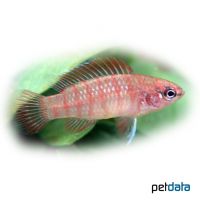Assambadis (Badis assamensis)
| Assambadis Badis assamensis | |
|---|---|
| Name | Assambadis |
| Name Lat. | Badis assamensis |
| Family | Chameleonfishes |
| Family lat. | Badidae |
| Order | Labyrinth Fishes |
| Order lat. | Anabantiformes |
| Origin | India |
| Habitat | Streams, rivers |
| Diet | Carnivore |
| pH | 6.0-7.5 |
| Behavior | ♂ territorial |
| Keeping | Pair, group |
| Care Level | Moderate |
| Reproduction | Cave spawner |
| Breeding | Simple |
| Life Span | 2-3 years |
| Protection | No |
| Metric Units | |
| Size | 5-7 cm |
| Temperature | 20-24 °C |
| Hardness | 3-10 °dH |
| Aquarium | 100 l |
| US Units | |
| Size | 2"-2.8" |
| Temperature | 68-75 °F |
| Hardness | 53-178 ppm |
| Aquarium | 25 gal |
Distribution and habitat
The distribution area of the Assam Bluefish is in northeastern India. They live there in small, slow-flowing, weedy pools, forest streams and small rivers with dense underwater and riparian vegetation.
Maintenance
The aquarium should have dense planting, with plenty of hiding places, such as roots, stone caves, bamboo tubes or halved coconuts and free swimming space. A dark substrate and some subdued light (floating plant cover) are ideal
No ammonia, ammonium and nitrite should be detectable, the nitrate value should not exceed 100 mg/l. To ensure the water quality and oxygen content, a filter and heater adapted to the aquarium size is required, as well as lighting for the species-appropriate day-night rhythm of the animals.
Diet
In the wild they feed on insect larvae, small crustaceans and zooplankton. The food supply consists of live and frozen food. Feed once daily with cyclops, daphnia, bosmids or artemia (live or frozen). Protein-rich, sinking dry food is very rarely accepted and should not be the main component of the diet.
It is recommended to feed small portions several times a day, which are eaten within a few minutes. A regular and varied diet promotes health and increases resistance.
Behaviour and compatibility
They should be kept in pairs or groups. The otherwise quite peaceful fish form small territories that are consistently defended, so keeping several pairs or groups is only recommended in a larger and richly structured tank. In a community tank they behave less territorial than in a species tank. They should not be socialized with other overly lively fish.
Basically, only compatible fish species with similar demands on water quality and water temperature should be socialized.
Sex dimorphism
The sexes are difficult to distinguish. The males are more colorful and have larger caudal fins than the smaller and more rounded appearing females
Reproduction and breeding
The females spawn 30-100 eggs in small caves (cave breeders). The male takes over the brood care and guards the larvae, which hatch after 2-3 days and swim free after a maximum of 7 days.
Fry must be fed several times a day with special rearing food (cyclops or Artemia nauplii). In a community tank breeding is hardly possible, because the fry are easy prey.
Important
The well-being of the fish should be checked regularly. The temperature should be checked daily, the pH, hardness and nitrate value at least every 14 days. A regular partial water change is recommended, even if the pollutant load has not yet reached the upper limit. Sudden changes in water quality should be avoided. Newly introduced fish must be accustomed slowly to the water in the aquarium.
Further literature can be found in your pet store.
References
Text: petdata; Image: petdata
Source: BMELV (1998): Tierschutzgutachten - Haltung von Zierfischen (Süßwasser); BAENSCH & EVERS (2004): Aquarien Atlas Bd. 6, Mergus Verlag; ENGELMANN (2005): Zootierhaltung - Tiere in menschlicher Obhut: Fische, Verlag Harri Deutsch
- Gemäß § 21 Abs. 5 Tierschutzgesetz idgF
